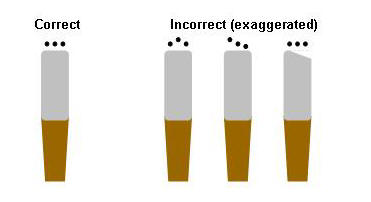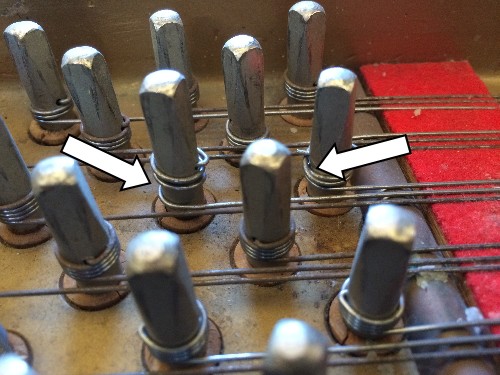




|
|
A few words about "Service"
 |
I strive to
provide the highest quality professional and technical services.
Whether you are an accomplished pianist or someone just starting out, I
will take the time to make sure you understand everything I plan to do (along with an estimate) before I start working.
For me, it's all about customer satisfaction. If
for any reason you're not happy with my work, then I'm not happy -- I
will extend every effort to correct the situation. |
I
believe piano maintenance to be much more than just keeping your
instrument in tune. Lets review your piano to determine what's
needed to bring it to peak performance.
* * *
GENERAL PIANO SERVICES
I offer three levels of general tuning and piano service:
1) Basic Tuning ($200*): Tune to A-440. Check
and adjust pedals. This service is best for pianos that are tuned
regularly and are well maintained. A single-pass tuning usually
takes about 45 minutes. But I try to leave a little extra time in
my schedule for minor regulation or voicing
if needed.
Why should I have my piano regularly tuned?
Your piano is made of materials such as wood,
leather, adhesives and felt which respond to the environment.
So even if the piano is not being played regularly, its pitch can
change in response to humidity or temperature variations (humidity
tends to be the strongest driver - the pitch rises as humidity goes
up). Your piano was designed to be tuned to the international
pitch standard of 440Hz. It will sound its best when tuned to
this pitch. Maintaining this pitch is also important if you
have children in the household (so that they learn to remember pitches
correctly) or if you regularly play with other instrumentalists or
vocalists. Most piano manufacturers recommend four tunings in
the first year and twice a year after that.
But in the end, the question has a simple answer:
A tuned piano is more fun to play!
2) Full Service Tuning ($275*): Tune to A-440
(including a Pitch Raise -- two pass tuning if needed). Depending on the particular instrument: repairs, fix regulation issues
(pedals, action, keys or dampers), and voicing for any uneven notes. (A separate estimate
will be provided should more significant repairs, regulation or voicing
be indicated.) The Full Service Tuning is recommended for
anyone
who wants a more comprehensive service call. Also recommended
for recording sessions or performance venues. (Up to one and 1/2
hour).
Why would a piano need a "Pitch Raise"?
Over longer periods of time, pianos generally tend to drop in pitch.
If a piano is far out of
tune, it’s usually not possible to bring it up-to-pitch in a single
pass since tightening the strings at one end of the piano will throw
already completed sections out of tune.
A “Basic Tuning” assumes that the piano is close
to pitch and only requires a single pass. But if it’s been years since the last tuning, then it’s likely
that a “Pitch Raise” will be required which includes two passes
through the tuning process. (More than two passes may be needed if
it’s been many years since the last tuning.)
3) Tone Building & Voicing: Bed the keyframe,
seat
strings at bridges, level strings, file hammers for shape and string matching,
and tune to A-440. Voice the piano. For the most
discriminating grand piano owner, this process
brings your piano to peak performance for tone, power and dynamic range
by correcting hammer-to-string mating issues and voicing the instrument. This picture shows the types of alignment issues
that can occur:

* Prices are for Mid-town Manhattan. Prices may vary due to the piano's condition and are
subject change.
* There is a $75 cancellation fee when notice is given
48 hours or less prior to a confirmed appointment.
REGULATION
"Regulation" is the term for making all the needed
adjustments in the keys, action and pedals so that your piano can play
through its full dynamic range and with
good repetition. (There can be as many as 20 adjustments per
key.)
- Touchup Regulation: set hammer blow distance, adjust for lost motion, set let-off,
and adjust back checks
- Basic Regulation:
(repairs and adjustments necessary to bring regulation to a good level):
ease keys, check and correct key height/dip, adjust: blow distance, lost
motion, let off, checking, aftertouch, dampers to pedal, center pedal,
soft pedal and bridal wires.
- Complete Regulation: (all repairs and adjustments needed to achieve a fine
regulation). All Basic Regulation, plus: replace key punchings, level
and adjust keys, set key dip, align all action parts, space and travel
hammers, full damper regulation
REPAIRS
I am well equipped to
handle all repairs from simple problems (stuck key, broken
string, squeaky pedal) to more complex issues.
|
|
|
| Replacing broken strings is a
common piano repair. There are many subtleties to getting
it "just right" and this is just one example were hiring an
experienced technician pays off.
The picture to the right shows examples of a
poorly done string replacement. The left arrow points to
coils that were not properly "snugged" in place, which can
result in unstable tuning for that note. On the right, one
coil overlaps another again resulting in unstable tuning and
possibly premature string breakage. |
 |
|

